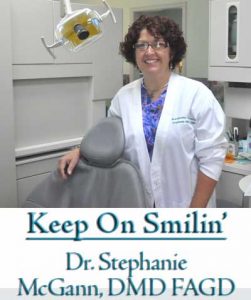By Dr. Stephanie McGann, DMD FAGD, Columnist, The Times
 When I was building my first office, I was amazed by the tremendous amount of time, energy and money that was needed for things that I felt had no direct relation to patient care. Decades later, the only difference is that each and every one of these tasks I have learned has a very direct relationship to patient care. It’s the side of a dental practice that is invisible, behind the curtain.
When I was building my first office, I was amazed by the tremendous amount of time, energy and money that was needed for things that I felt had no direct relation to patient care. Decades later, the only difference is that each and every one of these tasks I have learned has a very direct relationship to patient care. It’s the side of a dental practice that is invisible, behind the curtain.
Not long ago, a patient who was sitting in my reception area (by choice – she came early to enjoy some air conditioning) commented on the number of things that seem to happen that she never knew about. I was a bit confused, until I realized that during the time she was there she was observing many of those “behind the scenes moments.”
Our office manager was reviewing all of the mandatory training programs that each team member must participate in. In some cases as many as 30 or 40 hours in a year. This adds up to an entire week of work without even seeing the first patient. These requirements are as mundane as OSHA training, HIPPA reviews, Child abuse identification and reporting, CPR, radiology reviews for team members licensed to take x-rays and many more that fall under mandatory continuing education.
That’s when I decided to pull back the curtain and show what we do. Everyone knows we sterilize our instruments between each patient. But did you know that our instrument packs are marked with indicators, verifying that the instruments went through the autoclave? Our autoclaves are tested weekly by an independent agency verifying that they are working effectively. These tests are recorded and verified. I’ve never had a patient ask if our autoclaves were tested, yet each and every week they are.
Many items are single use to lessen the burden of sterilization and eliminate any potential cross-contamination. These items are part of the inventory of a dental office. Rarely a week goes by that the big brown UPS truck or the ever present FedEx man misses a stop at the office. That also means that we have waste to deal with.
It’s not all just trash. Sure we generate our fair share of trash, but some items are considered hazardous materials. Medical waste is one of those behind the scenes, little talked about, concerns.
Each month, a certified medical waste hauler visits the office and with all of the necessary manifests and forms takes our medical waste to be appropriately disposed of. The other hazardous waste is amalgam. That “silver – mercury” filling material of yesterday. When an old filling is removed the suction that grabs it up sends it to a separator that segregates the amalgam from the waste water. This very contaminated canister of used dental filling bits must be handled with extreme care. It is sent to a special facility for destruction.
Offices that still place silver mercury amalgam fillings must also separate the unused amalgam from the regular trash stream. Silver amalgam waste is forbidden in most wastewater streams.
One of the best parts of digital x-rays is the freedom from developing x-rays. Old fashioned x-rays came equipped with a lead insert in the film package. That lead could not be thrown in the trash. The chemicals that were used to develop the film were also considered hazardous waste and had to be handled accordingly.
Today we are concerned with protected information. That means shredders and special encryptions to protect medical and financial information. Once again, more training and more special waste streams. Even a hard drive from an old computer must be handled in such a way that any residual information it may contain is protected.
Then there is maintenance. Unlike a physician’s office, a dental practice is effective a mini surgical suite. The compressed air lines, suction lines, isolated water sources and equipment all need regular care and maintenance. Very few people know that the water that we spray in your mouth is sterile distilled water, which has been treated to prevent any growth of microorganisms, or what scientists refer to as biofilm.
These are just some of the examples of things that your dental team does to provide safe and effective dental care. Each member of the team works to make sure all of these processes happen smoothly and efficiently. So now you too have peeked behind the curtain.
Dr. Stephanie McGann, who has more than two decades of dental practice experience, is a resident of the Unionville area and along with her partner, Dr. Marie Scott, practice at The Brandywine Smile Center, a family-friendly dental practice in Concordville. Dr. McGann also owns a practice in Valley Township, Rainbow Valley Dental. She is a past President of the Chester/Delaware Dental Society and she is a Fellow of the Academy of General Dentistry.






